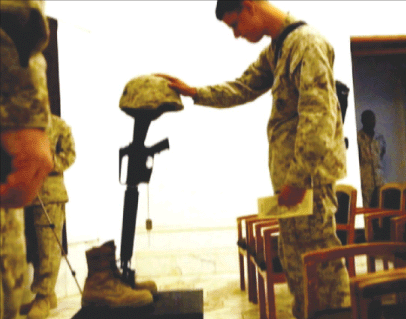War’s toll examined in potent documentary
Patricia Foulkrod’s documentary “The Ground Truth,” is a clarion call for Americans’ moral reckoning with the hundreds of thousands of our armed service members deployed in Iraq. Through interviews with 30 active and retired soldiers and their families, “The Ground Truth” circles from basic training to active duty and return home as veterans. The result is something like Industrialized Slaughter for Beginners, an unpretentious tutorial that gathers cumulatively devastative force.
From the main title, the curtain rises on a recruitment induction ceremony in Venice Beach, California. The crowd in the bleachers is pure Yankee-Doodle spirit; the young men in gray T-shirts on the dais are somber, perhaps swallowing back panic. At a recruitment outpost on the boardwalk, insecure dudes try on flak vests and helmets, and finger artillery. The recruiter shows a boy of seven or eight how to aim a grenade launcher. Three friends take turns signing the form on the clipboard.
Viewers’ preconceptions about the makings of today’s GI are meant to be corrected by interview accounts of boot camp. With awesome efficiency, the inhibition against murder is expunged, and drills are run in time to cadences modernized for Bush’s occupation. In his interview, Naval Petty Officer Charles Anderson performs a cadence he learned by heart in basic training: “Bomb the village, kill the people, / throw some Napalm in the square. / Do it on a Sunday morning, / kill them on their way to prayer.” He emphasizes the coercive “group dynamics” that enable such sentiments to pass undisputed.
Once in country, the new-minted soldiers instantly become dust in the maelstrom. Under Iraqi skies every American is a perpetual target, and troops are disposed to answer any threat or provocation—real or imagined—with overwhelming, often indiscriminate fire. Unsparing combat footage and still photos, some furnished by service members, disclose another few fractions of the reality behind the repeated-until-vacant phrase “civilian casualties.”
A third of the way in, the film shifts in tone as it refocuses on soldiers’ discharges and their return as permanently altered survivors. There are the obviously injured like Specialist Robert Acosta, who lost his right forearm to a grenade, or Specialist Denver Jones, a mellifluous tarheel whose spine was shattered, but even the physically intact are prone to post-traumatic stress disorder. As Sergeant Rob Sarra notes, “As these vets come back, you’re not gonna know who they are—they kinda ghost into society. They could be the quiet kid sitting in the back of a college class. They could be the kid who’s cleaning up at McDonald’s.”
Whether mental or physical, their wounds radiate outward, enveloping loved ones in myriad ways. Girlfriends and wives of some of the interviewees divulge the strain of adapting to life with debilitated partners. The seldom-broached phenomenon of veteran suicide—upwards of 200 in the first two years of the occupation alone—is articulated by the parents and sister of one combatant who took his life at 23 after coming home.
Under George W. Bush, the federal veterans bureaucracy has even dealt a lasting insult to those who served by attempting to renege on core benefits. Numerous voices attest to calls unanswered, claims mislaid, 120-day waiting periods, and even willful reclassification of diagnoses as “personality disorders” in order to deny services and conceal accurate figures of the burgeoning post-traumatic crisis. And we’ve come a long way from the GI Bill that underwrote higher education for returning World War II vets; Demond Morris instead describes the maddening paper maze thrown around his tuition benefits.
Foulkrod’s substantial television experience proves useful in lending the occasionally incendiary material an agreeable sheen. Reuben Aaronson, who photographed Marcel Ophüls Hotel Terminus (1988), limns a soft, unfussy DV image here, the staged interviews and spry observational footage enhancing the overall tenor of candid testifying. This comforting, transparent aesthetic steadies us through moments like the meeting with Staff Sergeant Josh Forbess, whose facial and cranial disfigurements a child might think were special effects.
“The Ground Truth” bends towards reconciliation, and in a spirit of holism largely ducks the war’s motives and false premises, so as not to exclude from its compassionate project either those who denounced the invasion of Iraq or those who hailed it. The film’s strategic prioritizing of the war’s home-front consequences, however, necessarily omits other considerations. For ourselves and succeeding generations of Americans, the domestic cost of the war will be steep indeed. But the ransacking and murder of a nation, wreaking catastrophe on an entire people, is something else again.
gaycitynews.com


































